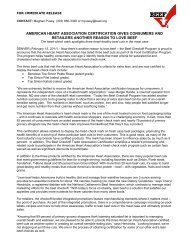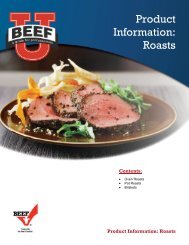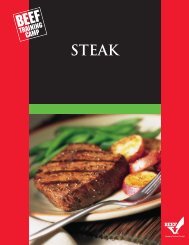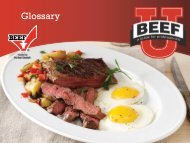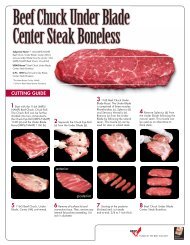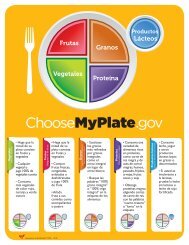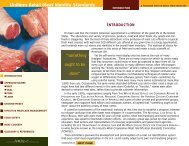Fact Sheet - Beef Foodservice
Fact Sheet - Beef Foodservice
Fact Sheet - Beef Foodservice
You also want an ePaper? Increase the reach of your titles
YUMPU automatically turns print PDFs into web optimized ePapers that Google loves.
suggest that tenderness of cooked beef was affected by individual muscle, USDA<br />
Quality Grade and length of aging. In general, USDA Select took longer than USDA<br />
Choice (upper 2/3) to complete the majority of all aging response.<br />
Packer/Processor Enhancements<br />
Most consumers enjoy beef “just the way it is” – that is, as tender and juicy cooked<br />
steaks, roasts or ground beef. Traditional methods of fabricating carcasses into<br />
individual steaks and convenient sized roasts and separating more tender from less<br />
tender cuts have contributed to great eating experiences for decades.<br />
However, as consumers’ tastes have evolved and our society has been introduced to an<br />
ever-growing variety of ethnic cuisines, today’s discerning customer often searches out<br />
those establishments that provide a variety of dining options.<br />
Progressive packers and processors are enhancing beef products at the processing<br />
level. By using items such prepackaged, ready-to-cook entrees, foodservice operators<br />
and retailers can expand offerings without extensive modifications to facilities or staff.<br />
One popular enhancement is the use of “marinating” technologies. The food industry<br />
defines a marinade as “… a mixture in which food is soaked, massaged, tumbled and/or<br />
injected to improve taste, tenderness or juiciness, or to impart other sensory attributes,<br />
such as color or flavor.” All prepackaged products must disclose on the label the amount<br />
of marinade and the ingredients used.<br />
Marination technology incorporates four basic elements: 1) closely trimmed beef, 2) a<br />
marinade solution, 3) a marination process and 4) a packaging system. The key<br />
difference among various marination processes is the degree of penetration and<br />
dispersion of the marinade, the amount of marinade absorbed, and the extent of<br />
tenderizing. A processor may use a variety of equipment (injectors, vacuum tumblers,<br />
vacuum massagers, etc.) that promote uniform distribution of marinade in beef. An<br />
unevenly distributed marinade can result in discoloration, a rubbery texture, pockets of<br />
strong flavor and/or uneven cooking.<br />
The ingredients in commercial marinating solutions perform specific functions. Primary<br />
ingredients – water, salt and phosphates – affect texture and water-holding capacity.<br />
Secondary ingredients – seasonings, acids and sweeteners – impart unique flavors.<br />
Primary marinade ingredients increase the meat’s water-holding capacity. Meat proteins,<br />
which make up about 20% of beef’s composition, can hold approximately four times their<br />
weight in water. Salts and phosphates enhance meat’s ability to hold water. This results<br />
in less moisture loss during cooking, thereby increasing the juiciness and perceived<br />
tenderness and can help minimize the impact of overcooking.<br />
Secondary ingredients (e.g., seasonings, sodium lactate, potassium lactate, sodium<br />
citrate, etc.) impart specific flavors, visual appeal and can provide extended shelf life.<br />
Trendy ethnic cuisines, such as Asian, Caribbean and Nuevo Latino, often influence<br />
marinade flavors. Today’s standby marinades, such as lemon pepper and teriyaki, are<br />
being joined by chili peppers, cilantro and other herbs. Care needs to be taken when<br />
adding seasonings to beef to complement its flavor. Unlike chicken and pork, beef has a





